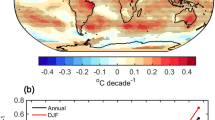Abstract
Analysis of terrestrially observed meteorological data is used to fill some of the gaps in our knowledge of the dust storm systems in a number of world regions.
In NW India and Pakistan, dust is raised from the alluvial soils of the Ganges and Indus and the Thar desert by localised convective cells (′Andhi′), while synoptic scale dust-raising and transport is caused by the ′Loo′ wind, a pressure gradient airflow. Mapping of twice-daily meteorological reports enables tracking of dust events which follow distinct patterns of dust transport. A tentative model of dust raising and transport in the area is proposed.
Below-average rainfall in the Sahelian latitudes of Mauritania, West Africa, which began in the late 1960s, has been partly instrumental in causing increases in dust-raising activity. At Nouakchott, data show the drought to have continued into 1986, with continued high levels of dust storm activity. Correlations of annual dust storm frequency with 3-year antecedent rainfall averages at Nouakchott, show significant relationships.
The frequency and distribution of dust storms in the Mongolian People′s Republic are mapped, showing highest activity in the Gobi desert and Great Lakes regions. The seasonality of dust storms (which occur largely in the spring) is controlled by ground surface conditions, the frequency of dust-raising meteorological systems, and in some areas by the actions of human populations. At Ulan Bator, increases in dust storms during the 1980s are related to human activities in and around the city.
Access this chapter
Tax calculation will be finalised at checkout
Purchases are for personal use only
Preview
Unable to display preview. Download preview PDF.
Similar content being viewed by others
References
Bertrand, J. (1977) ′Action des poussieres sub-sahariennes sur le pouvoir glacogene de l′air en Afrique de l′ouest′, Ph.D. Thesis, Universite de Clemont-Ferrand, France.
Bertrand, J., Cerf, A. & Domergue, J.L. (1979) ′Repartition in space and time of dust haze south of the Sahara.′ WMO, 538: 409–415.
Bhalotra, Y.P.R. (1951) ′Will it be a dust storm or a thunderstorm?′ Indian Journal of Meteorology and Geophysics, 5: 290–291.
Bhalotra, Y.P.R. (1955) ′On the role of upper level advection of cold air in the development of duststorms and thunderstorms over Delhi.′ Indian Journal of Meteorology and Geophysics, 6: 81–82.
Coude-Gaussen, G. (1984) Le cycle des poussieres eoliennes desertiques actuelles et la sedimentation des loess peridesertiques quaternaires. Bulletin Centre Recherche et Exploration-Production Elf-Aquitaine, 8: 167–182.
Goudie, A.S. (1983) ′Dust storms in space and time.′ Progress in Physical Geography, 7: 502–530.
Joseph, P.V., Raipal, D.K. & Deka, S.N. (1980) “ Andhi′, the convective duststorm of northwest India.′ Mausam, 31: 431–442.
Krishnan, A. (1977) ′A climatic analysis of the arid zone of northwestern India.′ In Jaiswal, P.L. (ed) Desertification and its Control. New Delhi: Indian Council of Agricultural Research: 42–57.
McDonald, W.F. (1938) Atlas of Climatic charts of the Oceans. Washington DC, Department of Agriculture: Weather Bureau.
Middleton, N.J. (1985a) ′Effect of drought on dust production in the Sahel.′ Nature, 316: 431–434.
Middleton, N.J. (1985b) ′Dust production in the Sahel: reply to M. Hulme.′ Nature, 318: 488.
Middleton, N.J. (1986) ′ A geography of dust storms in south-west Asia.′ Journal of Climatology, 6: 183–196.
Middleton, N.J. (1987) ′Desertification and wind erosion in the western Sahel: the example of Mauritania.′ Oxford: School of Geography Research Paper, 40.
Middleton, N.J., Goudie, A.S. & Wells, G.L. (1986) ′The frequency and source areas of dust storms.′ In Nickling, W.G. (ed) Aeolian Geomorphology. Boston: Unwin Hyman: 237–259.
Morales, C. (1979) ′The use of meteorological observations for studies of the mobilization, transport and deposition of Saharan dust. In Morales, C. (ed) Saharan Dust. SCOPE Report 14, Chichester: J. Wiley: 119–131.
Rao, Y.P. (1981) ′The climate of the Indian subcontinent. In Takiatash, K. & Arakawa, H. (eds) Climates of Southern and Western Asia. World Survey of Climatology, 9. Amsterdam: Elsevier: 67–118.
Rao, K.N., Daniel, C.E.J, & Balasubramaniam, L.V. (1971) ′Thunderstorms over India.′ Indian Meteorological Department Scientific Report No. 153.
Roy, S.C. (1951) ′Is the incidence of unusually dusty weather over Delhi in May and June for two consecutive summers of 1952 and 1953 an indication that the Rajasthan Desert is advancing towards Delhi?′ Indian Journal of Meteorology and Geophysics, 5: 1–15.
Singh, R.L. (ed) (1971) India: a regional Geography. Varanasi: National Geographical Society of India.
Sreenivasaiah, B.N. & Sur, N.K. (1939) ′A study of the duststorms of Agra.′. Memoirs of the Indian Meteorology Department, 27, part 1.
Srinivasan, V., Ramamurthy, K. & Nene, Y.R. (1973) ′Summer-Nor′westers and Andhis and large-scale convective activity over peninsula and central parts of the country. Indian Meteorological Department, Pune, Forecasting Manual, part 3.2.2.
Upadhyaya, V.C. (1954) ′Dust and thunderstorms on 23 March 1954 at Ahmedabad. Indian Journal of Meteorology and Geophysics, 5: 295.
Vaidyanathan, M. (1969) ′Unusual type of dust haze over Jodhpur Airfield and neighbourhood on May 13, 1963.′ Indian Journal of Meteorology and Geophysics, 20: 56–57.
Author information
Authors and Affiliations
Editor information
Editors and Affiliations
Rights and permissions
Copyright information
© 1989 Kluwer Academic Publishers
About this chapter
Cite this chapter
Middleton, N.J. (1989). Climatic Controls on the Frequency, Magnitude and Distribution of Dust Storms: Examples from India/Pakistan, Mauritania and Mongolia. In: Leinen, M., Sarnthein, M. (eds) Paleoclimatology and Paleometeorology: Modern and Past Patterns of Global Atmospheric Transport. NATO ASI Series, vol 282. Springer, Dordrecht. https://doi.org/10.1007/978-94-009-0995-3_4
Download citation
DOI: https://doi.org/10.1007/978-94-009-0995-3_4
Publisher Name: Springer, Dordrecht
Print ISBN: 978-94-010-6937-3
Online ISBN: 978-94-009-0995-3
eBook Packages: Springer Book Archive




